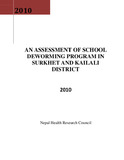Please use this identifier to cite or link to this item:
https://hdl.handle.net/20.500.14356/249Full metadata record
| DC Field | Value | Language |
|---|---|---|
| dc.contributor.author | Sapkota, Femila | |
| dc.date.accessioned | 2016-10-24T06:43:53Z | |
| dc.date.accessioned | 2022-11-08T10:11:38Z | - |
| dc.date.available | 2016-10-24T06:43:53Z | |
| dc.date.available | 2022-11-08T10:11:38Z | - |
| dc.date.issued | 2010 | |
| dc.identifier.citation | Nepal Health Research Council (NHRC) | en_US |
| dc.identifier.uri | http://103.69.126.140:8080/handle/20.500.14356/249 | - |
| dc.description.abstract | Background: Globally, one fourth of the people is infected with intestinal helminthes and is particularly prevalent among school-aged children in developing countries, which produce adverse negative impacts on education, health, growth, and school performance of the children. In Nepal School deworming program was started in fiscal year 2063/64 but till date there is no study conducted to see the coverage as well as the acceptance and effectiveness of the program. Hence, this type of assessment on one hand will provide the evidence of success of the program and in other hand will open door for evidence based design and effective implementation of more of such program. Methods: An assessment was done in Surkhet and Kailali District of mid and far western development region of Nepal. A total of 10% of all primary schools of Surkhet and Kailali District were selected randomly. All together 83 school teacher and 493 parents were included in the study. One key informant was selected from each District Public Health Office (DPHO) and District Education Office (DEO). The data collection tool for the interview was comprised of pre-designed semi-structured questionnaire as per the objective of the study. Moreover, the record on school deworming programme was reviewed to collect the data on deworming coverage from school/health institution record. Results: The study revealed that, majority of teachers (98.8%) had knowledge about school deworming program. Majority of the teachers (94%) told that the program was good for various reasons such as better for child health, prevention for worm infestation, and increased awareness among the people. Further 91.6% of the students participated voluntary for the intake of drug, 97.6% of student's intake drugs in the presence of the teacher and regarding provision of drug to those students who were ill in the day of drug distribution, it was found that majority of the schools (83.2%) provided drugs after they get well and resume the school. During program implementation phase 26.5% teachers faced some problems such as lack of provision of enough medicine timely from District Public Health Office. Similarly, 448 out of 493 Parents had knowledge about worm infestation. About 87.6% have heard about school deworming program and among them 70% knew about the program through their children. Majority (98%) of the respondent had good response toward the school deworming program. Conclusions: The overall perception of the parents and teachers toward the program was good and the coverage was also quite good. However, it can be said that drug therapy alone is only a short term measure for reducing worm infection in a target population. | en_US |
| dc.language.iso | en_US | en_US |
| dc.publisher | Nepal Health Research Council (NHRC) | en_US |
| dc.subject | children | en_US |
| dc.subject | deworming | en_US |
| dc.subject | program | en_US |
| dc.subject | school | en_US |
| dc.subject | worm infestation | en_US |
| dc.title | An Assessment of School Deworming Program in Surkhet and Kailali District | en_US |
| dc.type | Technical Report | en_US |
| Appears in Collections: | Research Abstract | |
Files in This Item:
| File | Description | Size | Format | |
|---|---|---|---|---|
| 627[1].pdf | PDF. | 1.29 MB | Adobe PDF |  View/Open |
Items in DSpace are protected by copyright, with all rights reserved, unless otherwise indicated.
